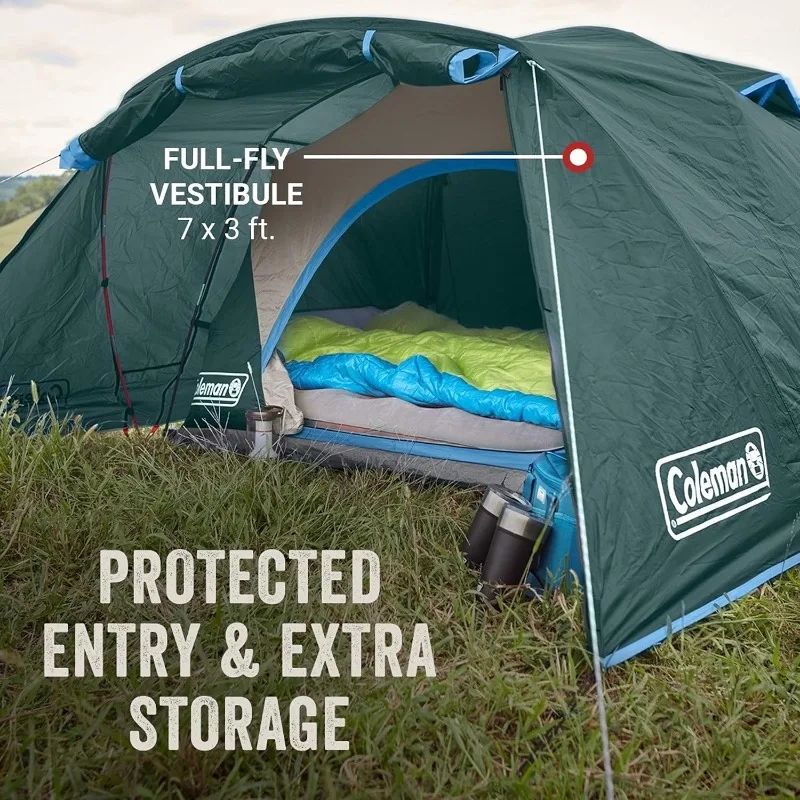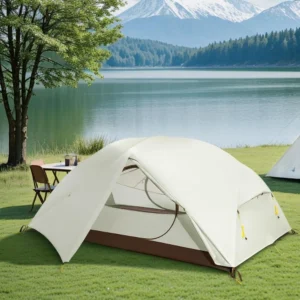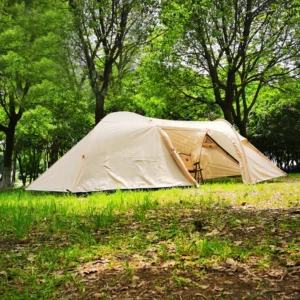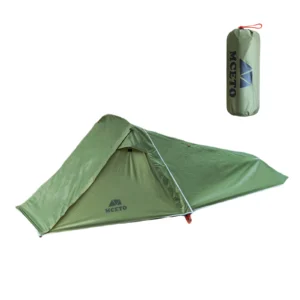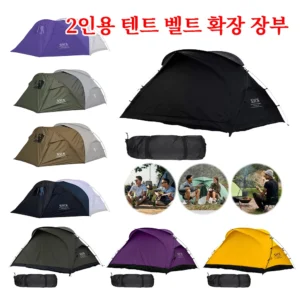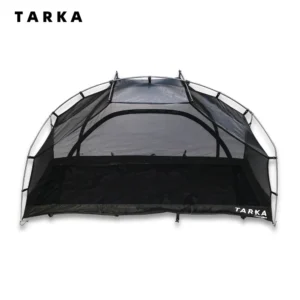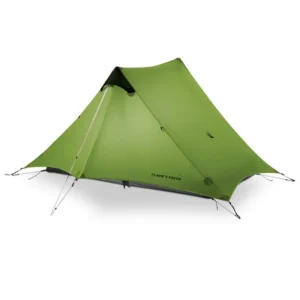Introduction: Unlocking Extra Space in Your Outdoor Home
A tent vestibule is a covered area outside the main sleeping area of your tent, typically created when the rainfly extends beyond the tent body. Think of it as your tent’s front porch or mudroom – a transitional space between the great outdoors and your cozy sleeping quarters. This often-overlooked feature has evolved significantly over the years, transforming from simple protective overhangs to sophisticated multi-room systems that fundamentally change how we experience camping.
Understanding the value of vestibules opens up a world of camping possibilities. They provide improved organization, essential protection from the elements, and dramatically expand your usable living space without increasing your tent’s footprint. The space advantage is significant – while a typical 2-person backpacking tent might offer 30 square feet of interior space, adding vestibules can provide an additional 8-10 square feet (0.7-0.9 m²) of protected area for gear and activities.
Throughout this guide, we’ll explore the practical benefits of tent vestibules, examine different vestibule types, and provide criteria for selecting the right option for your adventures. For campers looking to maximize limited space, vestibules represent one of the most impactful improvements to modern tent vestibule storage solutions and understanding what a tent vestibule can do for your camping experience is the first step toward more comfortable outdoor living.
What Makes a Tent Vestibule Different from Regular Tent Space
Tent vestibules serve as distinct functional zones rather than simply being “extra tent space.” Understanding these differences helps campers utilize these areas more effectively:
- Floorless design: Unlike the main tent body, most vestibules lack a floor, connecting directly to the ground. This creates a transition zone where dirt and moisture can be managed before entering the main tent.
- Material composition: While tent bodies often incorporate breathable mesh for comfort, vestibules utilize waterproof materials like 68-denier polyester with 1,500mm waterproof rating to handle direct exposure to elements.
- Structural integration: Vestibules are typically supported by the rainfly system rather than dedicated poles, making them integral to the tent’s weather protection system.
Think of vestibules as the mudroom of your home – a practical space where outdoor elements meet indoor comfort. They serve as a buffer zone between nature and your sleeping area, allowing you to keep wet, dirty, or bulky items outside your living space while still protecting them.
The benefits of tent vestibules extend beyond simple storage. They create functional spaces that serve multiple purposes depending on your needs. Many premium backpacking tents with vestibules are specifically designed to maximize this transitional space, recognizing that the vestibule is not merely an add-on but an essential component of the complete shelter system.
Essential Benefits: How Vestibules Revolutionize Tent Living
The addition of a vestibule transforms tent camping in several fundamental ways that enhance comfort, convenience, and protection:
Expanded Storage Capacity
Vestibules dramatically increase available storage space without expanding the tent’s footprint. This allows you to keep gear accessible but outside your sleeping area, freeing up valuable interior space. For backpackers, this means being able to store bulky packs, boots, and cooking equipment under protection without sacrificing precious sleeping room.
Weather Protection Zone
One of the most valuable aspects of vestibules is how they create dry transition zones. During rainfall, vestibules allow you to shake off wet rain gear, remove muddy boots, and organize equipment without bringing moisture into your sleeping area. This buffer zone keeps the interior of your tent significantly drier and cleaner.
Clean Living Maintenance
The separation between vestibule and sleeping area helps maintain tent hygiene. Dirty, wet, or muddy items stay in the vestibule while the main tent remains clean and dry. Without a vestibule, a sudden rainstorm means wet boots inside your sleeping space or left outside to fill with water. With a vestibule, boots stay dry but don’t occupy precious sleeping room.
Enhanced Privacy
Vestibules provide additional privacy for changing clothes, organizing personal items, or simply having a moment of solitude while still being sheltered. This becomes especially valuable during extended camping trips or when sharing a tent with others.
Pet Accommodation
For outdoor enthusiasts who camp with pets, vestibules offer an ideal sleeping area for animal companions – protected from elements but separate from the main sleeping quarters.
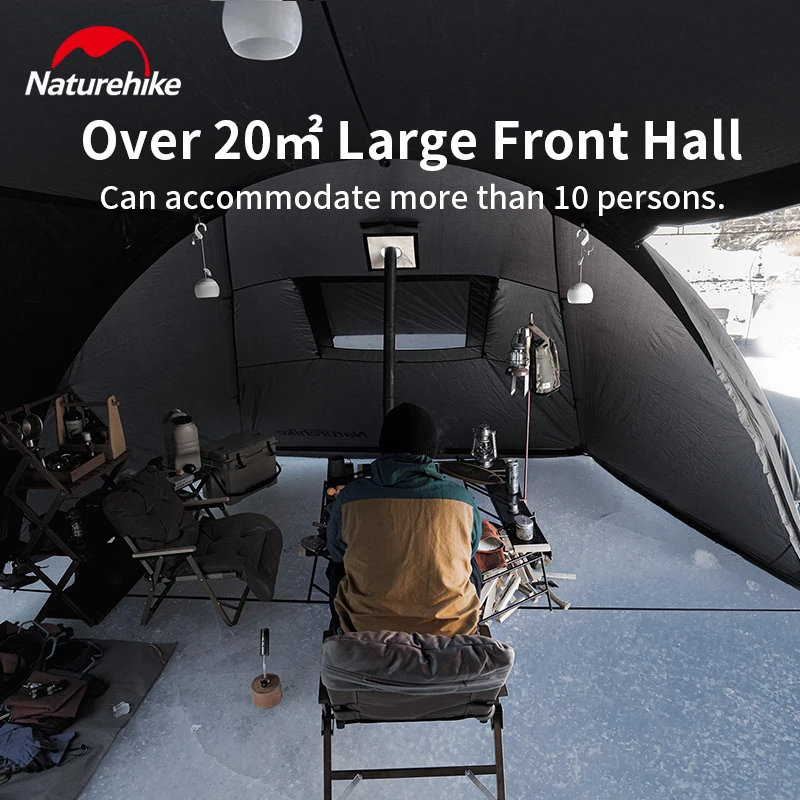
The comprehensive guide to weather protection tent vestibules explains how these spaces serve as more than just storage areas – they’re functional extensions of your living space. For family campers especially, camping tents with vestibule designs provide crucial organizational zones that keep camping equipment orderly and accessible.
Vestibule Designs: Matching Types to Your Outdoor Needs
Not all vestibules are created equal. Understanding the different designs helps you select the option that best matches your specific camping needs:
Front Entry vs. Side Entry Configurations
- Front entry vestibules typically offer larger coverage and storage space, making them ideal for group camping or situations requiring significant gear protection. They create a protective “awning” effect over the main entrance.
- Side entry vestibules tend to be more compact but offer convenient access directly from sleeping areas. They’re especially useful in tents designed for two or more people, providing individual entry/exit points without disturbing tent mates.
Single vs. Multiple Vestibule Layouts
- Single vestibule designs concentrate all protected external space in one area, simplifying setup and reducing weight. A tunnel tent typically features a large front vestibule offering 12 square feet (1.1 m²) of coverage.
- Multiple vestibule configurations distribute storage around the tent perimeter, ideal for shared accommodations. Dome tents often include smaller dual side vestibules of 6-8 square feet (0.5-0.7 m²) each.
Integrated vs. Add-on Options
- Integrated vestibules come built into the tent design, offering seamless protection and optimized stability in adverse conditions.
- Add-on/aftermarket vestibules provide flexibility to expand existing tents, though generally with some compromise in weather performance or integration.
Minimal vs. Extended Coverage
- Minimal designs prioritize weight savings while offering just enough space for essential gear storage.
- Extended coverage vestibules maximize protected area, sometimes creating fully functional sitting or cooking spaces outside the main tent.
For backpackers seeking maximum space efficiency, understanding different tent designs with expanded vestibules is crucial to finding the right balance of weight and functionality. Many ultralight trekking pole tents incorporate innovative vestibule designs that leverage hiking poles for support, eliminating the need for additional tent poles.
Maximizing Limited Space: Strategic Vestibule Organization
To get the most from your vestibule, strategic organization is essential:
Vertical Storage Solutions
Utilize the height of your vestibule by implementing hanging systems for gear. Small carabiners or gear loops attached to vestibule seams create vertical storage that doesn’t consume floor space. Hang lightweight items like headlamps, small bags, or damp clothing to keep them accessible and off the ground.
Strategic Placement Principles
Position your gear according to frequency of use:
– Most frequently accessed items should be closest to the door
– Heavy or bulky items work best along the perimeter
– Create a clear path to the tent entrance
– Keep cooking equipment near the vestibule opening for ventilation
Weather-Specific Organization
For rainy conditions, create a small threshold using a folded tarp section just inside the vestibule entrance to catch water from rain gear before it enters the main tent. During hot weather, position gear to maximize air circulation, keeping items that need to dry closer to ventilation areas.
Day/Night Transitions
Reorganize your vestibule at night to ensure early-morning essentials are easily accessible without disturbing tent mates. Consider keeping a headlamp, water bottle, and morning necessities in a designated spot for pre-dawn activities.
Expert campers excel at mastering tent vestibule organization through practices developed over multiple trips. For backpackers especially, understanding tent vestibules for backpacking camping situations requires balancing weight considerations against organizational needs.
Weather Protection: How Vestibules Create Micro-Climate Advantages
Vestibules create protective buffer zones that significantly enhance a tent’s weather management capabilities:
Rain Protection Benefits
- Vestibules prevent rain splash-back from entering the main tent body
- They create a dry transition zone for removing wet gear
- Extended vestibules allow tent doors to remain open for ventilation even during light rain
- They provide protected areas for gear that can’t fit inside the main tent
Wind Buffering Effects
In sustained 20 mph (32 km/h) winds with gusting, a well-positioned vestibule can reduce wind pressure on the main tent body by up to 30%. Vestibules break the direct force of wind before it hits the tent walls, improving overall stability and reducing noise inside the sleeping area.
Snow Management Capabilities
During winter camping, vestibules provide critical space for storing snow-covered equipment outside the sleeping quarters. This prevents snow melt from creating moisture issues inside the tent while keeping gear accessible and protected.
Heat Management Features
In hot conditions, vestibules with adjustable openings create shaded areas with improved air circulation. When properly ventilated, they help manage temperature differentials between the interior sleeping space and the outside environment.
Understanding what makes a tent windproof includes appreciating how vestibules contribute to overall structural stability. The aerodynamic benefits of properly designed vestibules extend beyond mere storage – they’re integral to the tent’s ability to withstand challenging weather conditions.
The Gear-Management Revolution: From Cramped to Comfortable
Vestibules transform the camping experience by solving one of the most persistent tent challenges: gear storage and organization.
Space Recovery Inside Main Tent
A standard 9 square foot (0.8 m²) vestibule can comfortably accommodate two 65-liter backpacks, hiking boots, trekking poles, and a small camp chair—items that would occupy roughly 40% of the floor space in a typical 2-person tent. This dramatic space recovery transforms the main tent from a cramped gear closet into a comfortable living area.
Accessibility Improvements
Vestibules allow for logical organization of equipment based on use patterns:
– Rain gear stays in the vestibule for quick access during showers
– Cooking equipment remains separate from sleeping areas
– Dirty or wet items have a dedicated space away from clean, dry gear
– Bulky items that are only needed occasionally remain protected but out of the way
Before/After Comparison
Before vestibule use: Backpacks occupy corner spaces, boots create dirt near sleeping areas, cooking equipment consumes valuable floor space, and wet gear must either come inside or remain exposed outside.
After vestibule implementation: The main tent contains only sleeping equipment and personal items, while all utility gear remains organized and accessible in the vestibule, dramatically improving comfort and livability.
For those with existing tents looking to improve their camping experience, exploring options to add a vestibule to your tent can be a cost-effective alternative to purchasing an entirely new shelter system.
Cooking, Camp Chores, and Safety Considerations
While vestibules provide convenient covered areas for various activities, safety must be the primary consideration:
Cooking Safety Guidelines
CRITICAL SAFETY WARNING: Never cook inside a completely enclosed vestibule due to carbon monoxide and fire risks. Always ensure adequate ventilation when performing any cooking activities near tent materials.
- Maintain at least 12 inches (30 cm) between any heat source and vestibule walls
- Ensure at least 2 square feet (0.2 m²) of open ventilation area when performing any cooking activities
- Never leave cooking equipment unattended in a vestibule
- Consider alternative approaches like cooking under a separate tarp or using the vestibule only during very light rain with maximum ventilation
Safe Storage Practices
Certain items should never be stored in vestibules:
– Fuel canisters (keep these well away from the tent in a separate location)
– Food in bear country (use proper bear canisters away from your tent)
– Wet items placed directly against tent walls (can cause seam leakage)
– Extremely valuable items (vestibules typically can’t be secured)
Ventilation Techniques
Proper airflow is essential for vestibule functionality:
– Configure doors and vents to create cross-ventilation
– Use guy lines to maximize opening sizes during fair weather
– Position the tent to allow prevailing breezes to flow through vestibule areas
For campers facing challenging conditions, waterproof backpacking tents with well-designed vestibules provide crucial protection while maintaining safety through proper ventilation features.
Lightweight Backpacking Tent, Ultralight Backpacking Tent, Waterproof Backpacking Tent
$391.05 Select options This product has multiple variants. The options may be chosen on the product pageCamping Tent with Vestibule, Waterproof Camping Tent
Price range: $407.89 through $479.48 Select options This product has multiple variants. The options may be chosen on the product pageBackpacking Tent with Vestibule, Freestanding Backpacking Tent, Lightweight Backpacking Tent
Price range: $446.89 through $447.22 Select options This product has multiple variants. The options may be chosen on the product pageBackpacking Tent with Vestibule, Trekking Pole Backpacking Tent, Waterproof Camping Tent
Price range: $271.99 through $519.52 Select options This product has multiple variants. The options may be chosen on the product pageUltralight Backpacking Tent, Ultralight Trekking Pole Tent
Price range: $350.87 through $351.98 Select options This product has multiple variants. The options may be chosen on the product pageLightweight Backpacking Tent, Trekking Pole Backpacking Tent, Ultralight Trekking Pole Tent
$850.00 Select options This product has multiple variants. The options may be chosen on the product page
Selecting the Right Vestibule Design: Decision Factors for Your Adventures
Finding the ideal vestibule configuration requires evaluating your specific camping needs:
Trip Type Considerations
- Weekend camping: Comfort features and space might take priority over weight
- Thru-hiking: Weight becomes paramount; minimal vestibules save ounces
- Base camping: Extended vestibules create valuable living space for longer stays
- Winter expeditions: Larger vestibules accommodate extra gear and provide cooking space
Climate and Terrain Factors
- Hot, humid environments benefit from vestibules with extensive ventilation options
- Alpine conditions may require storm-worthy vestibules with stronger materials
- Desert camping might prioritize sun protection and sand management features
- Rainy environments demand generous vestibule space for wet gear management
Weight vs. Space Trade-offs
A large 14 square foot (1.3 m²) vestibule may add 8-10 oz (230-280 g) to your pack weight, while a minimal 7 square foot (0.7 m²) design might add only 4-6 oz (110-170 g). Consider your priorities carefully – ultralight backpackers may choose minimal options, while comfort-focused campers might accept additional weight for expanded space.
Cost Considerations
Vestibules typically increase tent cost by 15-25%, though this varies between manufacturers. Consider your camping frequency and conditions to determine if this investment delivers appropriate value for your specific needs.
Understanding how much a backpacking tent should weigh helps place vestibule considerations within your overall equipment strategy, balancing protection against pack weight.
Is a Vestibule Worth It? Balancing Trade-offs for Your Camping Style
While vestibules offer significant benefits, they’re not without drawbacks that each camper must evaluate:
Potential Limitations
- Weight penalty: Additional materials add weight to your pack
- Setup complexity: More components can mean more complicated pitching
- Cost increase: Vestibules add to the overall tent price
- Footprint expansion: Larger ground area requirements may limit campsite options
Maximum Value Scenarios
Vestibules provide the greatest benefit when:
– Camping in variable or wet weather conditions
– Trips lasting multiple days with substantial gear
– Sharing tent space with partners or groups
– Camping with pets or children
– Locations where keeping gear clean and organized is challenging
Minimal Value Scenarios
Vestibules might be unnecessary when:
– Fair weather camping is guaranteed
– Ultralight missions prioritize absolute minimum weight
– Very short overnight trips with minimal gear
– Camping styles that include separate shelters for gear
For campers seeking optimal gear storage solutions, exploring best tents with gear storage vestibules helps identify designs specifically engineered to maximize the vestibule advantages while minimizing the associated trade-offs.
Aftermarket Options: Adding Vestibules to Existing Tents
For those not ready to purchase an entirely new tent, aftermarket vestibule options provide a way to enhance existing shelters:
Compatibility Considerations
- Check manufacturer offerings for model-specific vestibule additions
- Verify attachment methods (clips, Velcro, zippers) match your tent design
- Confirm height and width dimensions are appropriate for your tent model
- Consider rainfly overlap requirements for waterproof connections
Universal Solutions
Universal vestibules typically attach via adjustable straps and can add 6-8 square feet (0.5-0.7 m²) of covered space to most tent designs, though weather protection is generally less complete than with integrated designs. These options work best in moderate conditions rather than extreme weather.
DIY Approaches
Some creative campers fashion custom vestibules using:
– Tarps with appropriate attachment points
– Silnylon fabric cut and seam-sealed to custom dimensions
– Modified rain flys from compatible tent models
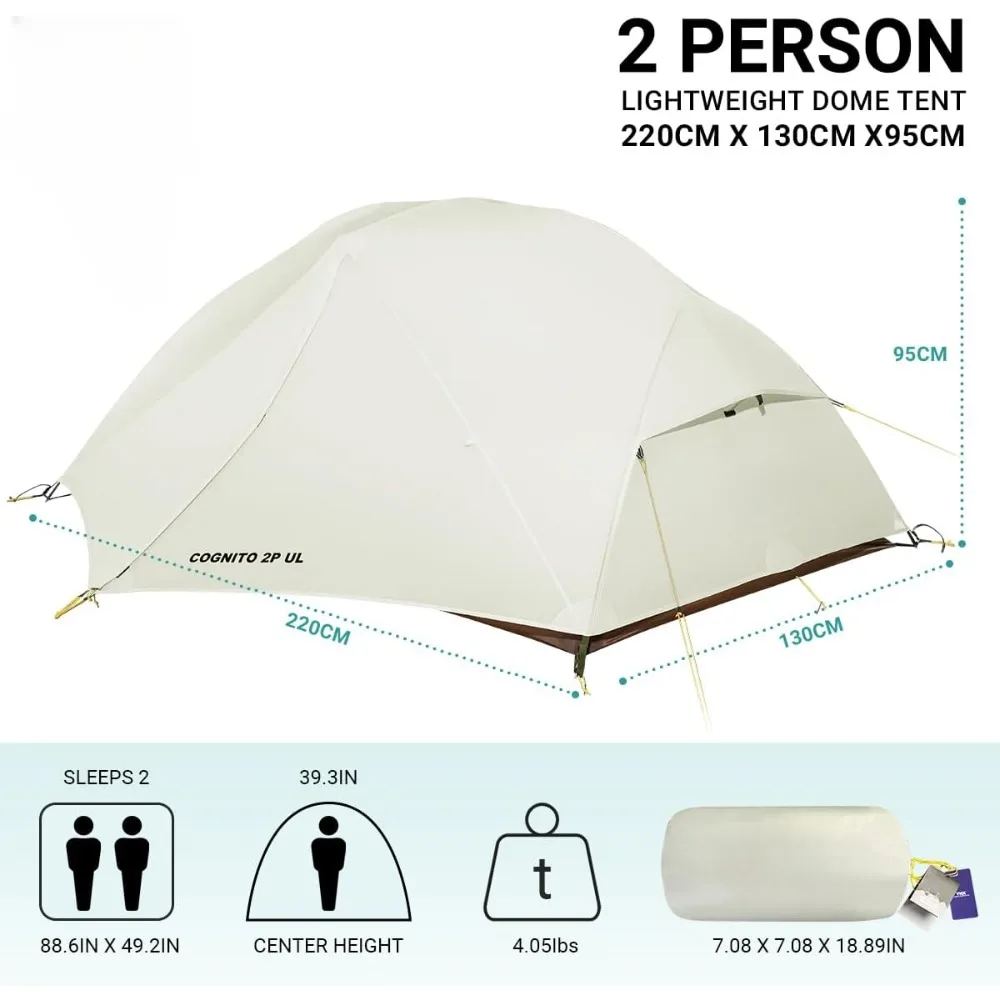
Frequently Asked Questions: Solving Common Vestibule Challenges
Can you sleep in a vestibule?
While technically possible, sleeping in vestibules is generally not recommended. Most lack insect protection, ground cover, and proper ventilation. In emergency situations, using a separate groundsheet (like a small piece of Tyvek) can make it possible, but it should not be planned as regular sleeping space.
How do you keep a vestibule floor clean?
While most vestibules are floorless, laying down a small piece of Tyvek or polycryo plastic measuring approximately 3×4 feet (90×120 cm) creates an effective ground barrier that weighs under 2 oz (55 g). This creates a clean zone for gear organization and transitioning into the main tent.
Are all vestibules floorless?
Most vestibules are floorless by design, but some premium tent models offer vestibule groundsheets as optional accessories. These connect to the main tent body and provide complete floor coverage throughout the vestibule area.
Can vestibules be used in all weather conditions?
Quality vestibules are designed to withstand the same weather conditions as the tent itself. However, in extreme winds, vestibules create additional surface area that catches wind, so proper staking and guying become even more critical than with the main tent body.
How do you prevent condensation in vestibules?
Maintaining proper ventilation is key to managing condensation. Keep at least one vestibule door partially open when possible, and utilize all available venting options. Avoid storing excessively wet items in completely closed vestibules overnight.
Can vestibules be pitched independently from the main tent?
Some vestibule designs, particularly those on trekking pole tents, can be set up independently as minimal shelters. However, most standard tent vestibules require attachment to the main tent for structural stability.
Beyond Storage: Creative Uses That Maximize Vestibule Value
Innovative campers find multiple ways to utilize vestibule space beyond basic storage:
Photography Workstation
During poor weather, a vestibule provides protected space for changing lenses, downloading memory cards, or cleaning camera equipment without exposing sensitive electronics to the elements.
Morning Coffee Spot
Early risers can enjoy morning beverages in the vestibule without disturbing sleeping tent mates. By securing a small clothesline diagonally across your vestibule at approximately 5 feet (150 cm) height, you can create an effective drying system for damp socks and smaller garments.
Pet Paradise
For camping with animals, vestibules create ideal sleeping areas that keep pets protected while maintaining cleanliness in the main tent. Adding a small dedicated pet pad makes the space comfortable for four-legged camping companions.
Nature Observation Post
During rainfall, partially opening vestibule doors creates a perfect sheltered viewpoint for wildlife watching, reading, or simply enjoying the sounds of nature while staying dry.
Gear Transition Zone
For sports like climbing, fishing, or hunting, vestibules serve as perfect places to transition between “field mode” and “camp mode” – removing specialized equipment before entering the main living space.
At Explore Elements, we understand that versatile vestibule design represents one of the most significant advances in modern tent technology. By thoughtfully incorporating these extended spaces into your camping strategy, you transform your outdoor shelter from a simple sleeping space into a comprehensive living system capable of enhancing comfort across all conditions and adventures.

